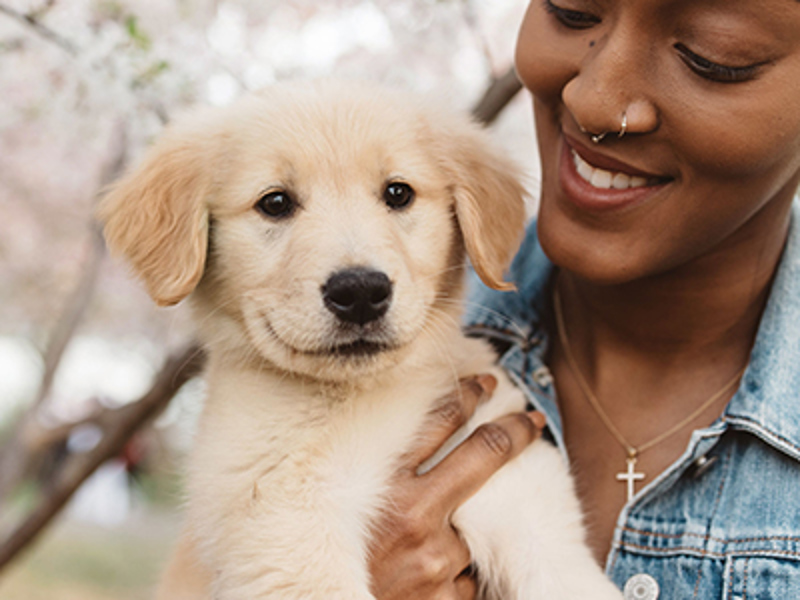
Cavalier King Charles Spaniel
Breed characteristics
- Size
- Small
- Exercise
- Up to 1 hour per day
- Size of home
- Flat/ Apartment
- Grooming
- More than once a week
- Coat length
- Medium
- Sheds
- Yes
- Lifespan
- Over 12 years
- Vulnerable native breed
- No
- Town or country
- Either
- Size of garden
- Small/ medium garden
About this breed
Toy spaniels can be traced back to at least the 16th Century and, as with many other of the toy breeds, it is likely that they were bred down from sporting breeds. Queen Elizabeth I had a ‘spaniel gentle’ as a comforter, a dog popular with noble ladies as playthings and bed warmers. The spaniel of Mary, Queen of Scots was found hidden in her petticoats after she was beheaded. However, it was in the courts of Charles I and his son Charles II that the toy spaniels became well established and their popularity spread, particularly amongst the nobility. The first Duke of Marlborough developed the Blenheim spaniel, a rich red and white dog which retained its sporting instincts and was adept at flushing game. Its name comes from the Duke’s residence, Blenheim Palace, and the word is used today to describe the chestnut and white coat colour. The Duke of Norfolk also kept the Blenheim type but developed the black and tan variety. The tricolours were called the Prince Charles. The ruby colour was the last colour to be developed in the breed.
Until the late 19th Century the toy spaniels retained the fairly long muzzle and the flattish skull of the sporting spaniels. However, the fashion for shorter muzzles in the toy breeds, as seen in the Pug and the Pekingese, lead to the domed skull and shorter muzzle becoming more popular and more successful in the show ring. A group of breeders were saddened by the apparent decline of the slightly larger type dogs with slightly longer muzzles, flatter skulls, and which retained their sporting instincts. At Crufts in 1926-1930, there were special prizes given for ‘Blenheim spaniels of the old type’ and the word ‘Cavalier’ was chosen to distinguish this type from the flatter-faced type which was known as the King Charles. This effectively saw the emergence of the Cavalier King Charles (the old type) as a separate variety from the King Charles. The Cavalier King Charles Spaniel Club was formed in 1928 but The Kennel Club did not recognise the Cavalier as a separate breed until 1945.
Images for this breed
The Toy breed group
The Toy breeds are small companion or lap dogs. Many of the Toy breeds were bred for this capacity although some have been placed into this category simply due to their size. They should have friendly personalities and love attention. They do not need a large amount of exercise and some can be finicky eaters.
Colour Watch
Category 0: Breeds with no NBS colour registration options.
Read more about Colour Watch.
Breed Standard colours
Breed standard colour means that the colour is accepted within the breed standard and is a traditional and well-known colour in this breed.
Breed standard colours in this breed include:
- Black & Tan
- Blenheim
- Ruby
- Tricolour
Other colour/s
'Other' means you consider your puppy to be a colour not currently known within the breed and one that does not appear on either the breed standard or non-breed standard list. In this instance you would be directed through our registrations process to contact a breed club and/or council to support you on identifying and correctly listing the new colour.
Non-breed-standard colours
Non-breed-standard colour means that the colour is not accepted within the breed standard and whilst some dogs within the breed may be this colour it is advised to only select a dog that fits within the breed standards for all points.
Colour is only one consideration when picking a breed or individual dog, health and temperament should always be a priority over colour.
Health
Whether you're considering buying a Cavalier King Charles Spaniel puppy or breeding from your dog, it's important to understand the health issues that may affect the breed and how they can be managed or avoided.
Pre-breeding Health Screening
Good Practice schemes and tests
We strongly recommend that breeders, at a minimum, conduct these tests before breeding, as evidence indicates these conditions are a significant concern in the breed
- DNA test for Curly coat/ dry eye (CC/DE) - Find a lists of tested dogs here
- DNA test for Episodic falling (EF) - Find a lists of tested dogs here
- Heart screening (for mitral valve disease (MVD)) using the KC heart scheme for Cavalier King Charles Spaniels (supported by the VCS) - Find a list of tested dogs here.
Best Practice schemes and tests
These tests address conditions that are still significant for the breed, though they may not be as critical as those listed under Good Practice. They might be less common or newly identified, and research is ongoing to determine their full impact.
To support the breed’s health, responsible breeders should ensure they complete all tests in both categories. Following our Best Practice guidelines means completing both the Good Practice and Best Practice tests for your breed.
- Eye testing using the BVA/KC/ISDS Eye Scheme - Find a lists of tested dogs here.
This breed can be affected by conformational concerns, more information can be found here
Click here to find out more about The Kennel Club's health standard
Find out about a particular dog's results
Please visit our Health Test Results Finder to discover the DNA or screening scheme test results for any dog on The Kennel Club's Breed or Activity Register.
You can also view the inbreeding coefficient calculation for a puppy's parents, or for a dog you're thinking of breeding from.
DNA Testing Services
To support your health testing journey, we provide our tailored Cavalier King Charles Spaniel Breed-specific package. Giving you the information you need about potential health risks, this package includes CC/DE (Curly coat/dry eye), EF (Episodic falling)* and DNA Profile (SNP - ISAG 2020)
3 essential tests valued at £190 for just £150, that screen for multiple conditions at once, saving you time and providing vital health information.
Breed Health & Conservation Plan
The Breed Health and Conservation Plans
Our breed health and conservations plans (BHCPs) use evidence and data to help us understand the health issues found in each pedigree dog breed. These plans help breeders and owners identify health and welfare problems and use information, health tests and health schemes to avoid passing on those problems to future puppies. They also support and provide breeders with tools and specialist expertise to help manage genetic diversity, understand the impacts of close breeding, and find the best ways to preserve the population of their breed.
Working together for the breed
We’ve worked with breed clubs and breed representatives to gather all available evidence to help us determine the priority concerns for the breed and decide how we can work together to manage and reduce these problems.
Breed priorities
The current key priorities for the breed are:
- Heart disease (mitral valve disease – MVD)
- Chiari-like malformation (CM)/ syringomyelia (SM)
How we plan to make improvements
We’ve agreed the following list of actions with the breed clubs to improve the health of the breed. Both parties are committed to working on these areas and will review these on a regular basis to ensure the actions remain focussed and relevant to the breed’s health.
Breed club actions include:
- To discuss the publication of results from The Kennel Club heart scheme and write to The Kennel Club with views on this matter. – COMPLETE (this action was completed in 2021 with the Breed Clubs in agreement to publish results)
- To continue to encourage participation in The Kennel Club heart scheme. – ONGOING
- To put forward a proposal to the Assured Breeders scheme sub-group for The Kennel Club heart scheme to be added as a recommendation with the view to becoming a requirement for Assured Breeders in the future. – COMPLETE (this action was completed in 2021)
- To review the Breed Watch points of concern and write to the Breed Standards & Conformation sub-group with any amendments. – COMPLETE (this action was completed in 2020. As a note, the Breed Watch system is currently under review)
- To send dates of any upcoming health events they are holding to The Kennel Club for inclusion in the 2021/2022 health calendar. – IN PROGRESS (The Kennel Club are currently working on a new health clinic tool which will make uploading dates for upcoming clinics easier for organisers)
Our actions include:
- To assist the breed clubs with a Cavalier King Charles Spaniel health survey, particularly covering the conditions highlighted in the evidence base, using the Dachshund health and lifestyle survey as a template. – COMPLETE (the survey was closed in 2023, with the results to be included in the next Breed Health and Conservation Plan update)
- To review the CM/SM Scheme under the neurology development group. – IN PROGRESS (We are working with a group of specialists who form a neurology development group, as well as our partners at the BVA, to look at development of the scheme)
- To investigate whether mortality reporting can be incorporated into the website, and to follow up on heart scheme tested/ bred dogs. – IN PROGRESS (a morbidity and mortality reporting tool is currently in development)
- To put forward a proposal for The Kennel Club Charitable Trust subsidisation for heart scheme testing. – COMPLETE (this action was completed in 2021, with the Kennel Club having provided subsidises for heart testing for 2021 and 2022)
The full evidence base is available at the discretion of the breed clubs, however if you would like to seek access to the full report, please contact
Health and Breeding Support Team (The Kennel Club)
.
How do I use this information?
Breeders should be mindful of the top priorities in their breed and ensure they are working to reduce and eliminate the presence of these diseases when choosing to breed their dogs.
Puppy buyers should also be aware of these issues and be sure to ask their breeder how they are contributing towards the above actions, and whether any of these problems have been seen in their breeding lines.
More about health
Have any questions about health in your breed?
If you have any concerns about a particular health condition in your breed then you may wish to speak to your vet or you could contact your breed health co-ordinator.
Breed health co-ordinators are individuals working on behalf of breed clubs and councils who are advocates for the health and welfare of their chosen breed. They acts as a spokesperson on matters of health and will collaborate with The Kennel Club on any health concerns the breed may have.
To contact your breed health co-ordinator please email
Sheena Maclaine
Health issues in Cavalier King Charles Spaniels
Health screening is one way that responsible breeders are reducing the risk of passing on pre-existing conditions. There are three main health issues currently screened for in Cavaliers:
- Mitral Valve Disease (MVD)
- Syringomyelia (SM)
- Eye conditions
Mitral valve disease
Mitral valve disease is a common health problem in older dogs of all breeds, although it has been found to have an earlier onset in the Cavalier. The disease causes a degeneration of the heart’s mitral valve, often picked up as a heart murmur in younger dogs. Many dogs diagnosed with mitral valve disease continue to live to a good age and enjoy a happy life.
All Cavalier King Charles Spaniels that are being bred from should first be graded under The Kennel Club heart scheme.
Syringomyelia
Known by some as “neck scratchers disease” where the dog is seen scratching in the air near the neck, usually when excited or on a lead. The term syringomyelia is a condition where fluid filled cavities (syrinxes) develop within the spinal cord. While some dogs show no or only mild symptoms, unfortunately, in some cases the condition progresses and deteriorates, causing the dog pain and neurological problems. Medical interventions can help to alleviate health problems, but very sadly in some cases this is not possible.
Diagnosis for syringomyelia is by MRI scan. Veterinary clinics operating low-cost MRI scanning can be found on the Cavalier Club website together with advice and further information on syringomyelia.
The Kennel Club is currently undertaking a collaborative syringomyelia (SM) screening project with the Cavalier King Charles Spaniel breed and the British Veterinary Association, with the goal of better understanding the condition within the breed population. More information about the project can be found here.
Eyes
The main inherited genetic eye conditions in Cavaliers are cataract (congenital and juvenile) and multifocal retinal dysplasia. Fortunately both diseases are now much less common, as reputable breeders test their stock prior to breeding. However, you should check for the condition if you intend to breed from your Cavalier.
Health screening is an important part of illuminating health problems in any animal, but should you have concerns about any area of your dog’s health always seek and follow professional advice from your vet.
Breed watch
Category 2
Particular points of concern for individual breeds may include features not specifically highlighted in the breed standard including current issues. In some breeds, features may be listed which, if exaggerated, might potentially affect the breed in the future.
Breeding restrictions
There are a number of The Kennel Club's rules and regulations that may prevent a litter from being registered, find out about our general and breed specific breeding restrictions below.
More about breeding
It is genetically proven that two blenheim parents can only produce blenheim puppies. Therefore, with effect from 16 April 2007, puppies produced from two blenhiem parents will only be accepted for Kennel Club registration if they are blenhiem.
Looking for a puppy?
Looking for a Cavalier King Charles Spaniel? Explore our list of puppies and rescue dogs for sale near you.
More information

Need to find out more about a breed?
Use our Find a Club service where you can locate breed clubs that can offer support and advice.

Use our Find a Puppy service
The Kennel Club's Find a Puppy service provides contact details for breeders who have puppies available. Let's help you find your new best friend.

Get the best lifetime pet insurance
At Kennel Club Pet Insurance, we want you to focus on getting the best possible treatment for your dog without worrying about the cost.

